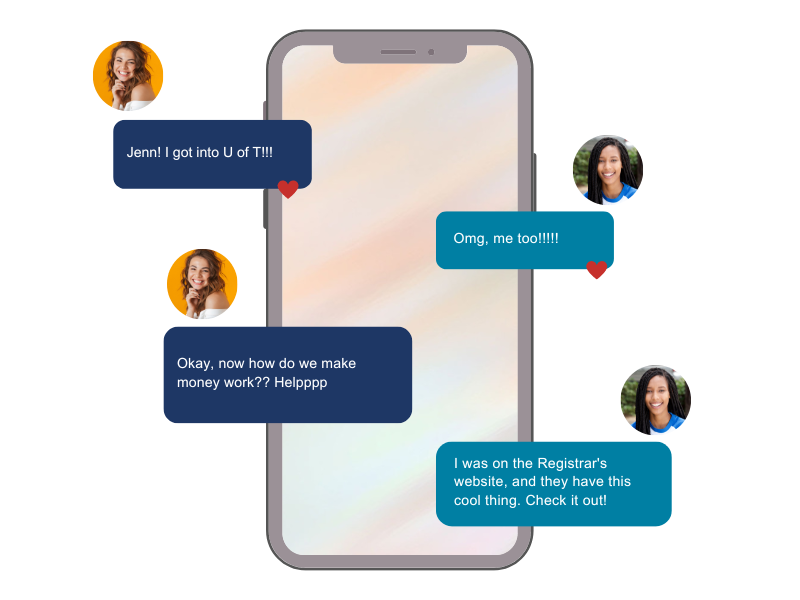Let's Talk Money
Money. It’s something we all deal with, but it’s not always easy to talk about—especially as a student. Between tuition, budgets, credit cards, and taxes, managing your finances can feel overwhelming. Here are some tips and tools to better understand your financial situation while at the University of Toronto.


What's Financial Literacy & Why Does It Matter?
Financial literacy is the knowledge and skills needed to make informed and responsible decisions about managing money. It includes:
- Key financial concepts – like budgeting, saving, and making smart spending and saving choices
- Financial products and services – like credit cards, student loans, and banking options
When you are financially literate, you can:
- Create a budget that helps you stay on top of your spending
- Make informed decisions about the different financial products available
- Plan ahead so unexpected expenses don’t throw you off track
Being informed now will help you beyond your time at university.
Budgeting & Setting Goals
Budgeting is a critical tool in managing your finances. It helps you track your income and expenses, stay on top of your spending, and work toward your financial goals—both now and in the future.
Why Should I Budget?
A budget gives you a clear picture of your financial situation and helps you:
- Keep track of your spending.
- Make better choices about saving and paying off debt.
- Plan ahead for expenses so you’re not caught off guard.
There’s no one-size-fits-all approach to budgeting. You can use a spreadsheet, an app, or even a notebook—whatever works best for you. The key is to list your funding sources (such as earnings, financial support, or savings) and expenses so you can see where your money is going.
How Do I Budget?
The Financial Consumer Agency of Canada provides an outline of steps for budgeting, including thinking about your financial goals, understanding where your money is going, and considering your needs compared to your wants.
Student Budget Examples
Example 1 – Undergraduate Student

Ana
2nd Year Student | Psychology and Visual Arts Program
St. George Campus
Ana is a full-time undergraduate student renting off-campus. Their program requires them to buy books and art supplies like paint, brushes, and canvases. They receive some financial support from their family, bursary funding, and earns additional income through a part-time Work Study job.
Since Ana is not an Ontario resident, they do not qualify for OSAP. To cover their remaining expenses—such as rent, groceries, and school supplies—the relies on a bank loan and credit card.
Ana's Budget Breakdown
Detailed budget breakdown for an 8-month academic year (September–April).
| Living Expenses | Amount Per Month | Total for 8 Months |
|---|---|---|
| Rent Payments | $950 | $7,600 |
| Utilities (hydro, electricity, etc.) | $50 | $400 |
| Internet | $20 | $160 |
| Public Transport (TTC, GO Transit, etc.) | $128 | $1,024 |
| Groceries | $400 | $3,200 |
| Total Living Expenses | $1,548 | $12,384 |
| Education Expenses | Amount |
|---|---|
| Tuition and Fees – Fall-Winter Term | $7,878 |
| Books and Materials | $1,686 |
| Total Education Expenses | $9,564 |
- Total Expenses (Living + Education) = $12,384 + 9,564 = $21,948
| Sources | Amount |
|---|---|
| Part-Time Work | $3,600 |
| Scholarships, Grants and Bursaries | $4,000 |
| Other Personal Savings | $2,000 |
| Family Contributions | $4,000 |
| Total Funding Sources | $13,600 |
- Total Expenses = $21,948 ($9,564 + $12,384)
- Total Funding Sources = $13,600
- Remaining Balance = Total Funding Sources – Total Expenses = -$8,348
Ana will have to explore additional funding sources to cover the remaining balance of $8,348.
Example 2 – Undergraduate Student

Jacky
3rd Year Student | Computer Science Program
Scarborough Campus
Jacky is a third-year student at the University of Toronto Scarborough. They lives at home during their studies, reducing their living expenses. From September to April, they are completing a co-op work term while taking two courses. They will return to full-time studies in the Summer session. Jacky received OSAP to help fund their Fall, Winter, and Summer studies.
Jacky's Budget Breakdown
Detailed budget breakdown for an 12-month academic year (September–August).
| Living Expenses | Amount Per Month | Total for 12 Months |
|---|---|---|
| Public Transport (TTC monthly pass to get to work and class) | $128 | $1,536 |
| Phone | $100 | $1,200 |
| Food | $330 | $3,960 |
| Total Living Expenses | $558 | $6,696 |
| Education Expenses | Amount |
|---|---|
| Tuition and Fees Fall and Winter ($4,143) + Summer($6,528) | $10,671 |
| Books and Materials | $681 |
| Total Education Expenses | $11,352 |
- Total Expenses (Living + Education) = $6,496 + 11,352 = $18,048
| Sources | Amount |
|---|---|
| OSAP (Fall and Winter term) | $5,885 |
| OSAP (Summer term) | $6,060 |
| Income from Co-op Placement | $24,000 |
| Total Funding Sources | $35,945 |
- Total Expenses for 12 months = $18,048
- Total Funding Sources = $35,945
- Remaining Balance = Total Funding Sources – Total Expenses = +$17,897
Jacky will not need to explore additional funding sources, as their expenses are fully covered.
Resources
- Financial Consumer Agency of Canada –explains why you should make a budget, how to do it, and provides tips for sticking with it.
- Government of Canada – provides tips and tools to help you become savvy about your finances, and make good financial decisions.
- U of T’s Student Life – provides examples of living costs to use in developing a draft budget.
Determining Your Expenses
Expenses are costs you need to cover, either as a one-time payment or on an ongoing basis (such as monthly, or yearly). These may include housing, food, tuition, books, a computer or other equipment, and clothing. The links in this section can help you identify different types of expenses and explore ways to manage or reduce your costs throughout the year.
Costs to Consider
When creating your budget, consider these common expenses. Your individual costs may vary depending on your personal circumstances.
Estimating your costs helps you plan a realistic budget. Consider all expenses and include amounts that apply to you. See common expenses to help you build your budget.
Your tuition depends on factors like program, year, course load, and campus. Check your fee schedule [ADD LINK HERE & ABOVE WITH ARROW] and add it to your budget.
Groceries can add up fast! Save money by meal planning, shopping with coupons, or using apps like FLIPP to find sales. UTSU has tips on affordable eating and budgeting.
Find local housing costs, rental listings, and key renting tips for the Greater Toronto Area (GTA) through this resource. Details on rental costs in Toronto and GTA.
Credit Management
What is Credit?
Credit is the ability to borrow money or access goods and services with the agreement to pay later. When used responsibly, it can help build a strong financial history and provide access to larger loans in the future. However, mismanaging credit can lead to debt and financial difficulties.
Learn how to build and manage credit responsibly to support your financial well-being in the long term.
Credit Score & Report
A credit score is a three-digit number that reflects your credit history and financial habits. Scores between 660 and 900 are considered very good to excellent. Your credit score changes over time based on factors like payment history, types of credit, and recent credit inquiries.
A credit report is a detailed record of your credit history and current financial standing. It includes information such as credit accounts, payment history, and outstanding balances. Your credit report is created when you first borrow money or apply for credit.
Awards, Grants & Loans
There are various sources of government and university funding for students. Government sources include loans and grants. University sources include scholarships and grants. These resources will help you get started with finding funding options and how to apply for them.
The University of Toronto offers need- and merit-based funding through academic divisions (and colleges), the University Registrar’s Office, and the School of Graduate Studies.
Search Award ExplorerThe government offers financial student aid, including grants and loans. Grants don’t need to be repaid, while loans require repayment after graduation.
See student aid options by province or territoryFind scholarships through a searchable database based on province, award value, program, and student level.
Search ScholarshipsCanada Browse StudentAwardsEarning income can help manage expenses while studying. The University of Toronto offers various work opportunities for students.
Work While Studying
Eligibility to Work in Canada
To work at the University of Toronto, you must be eligible to work in Canada. Check your eligibility through the Government of Canada.
Getting a Social Insurance Number (SIN)
A SIN is required to work in Canada and to register your information in ACORN. Learn more about how to apply for a SIN.
On-Campus Work Opportunities
- Work Study Program – Provides paid on-campus jobs for eligible students. Learn more about Work Study opportunities.
- Career & Co-curricular Learning Network (CLNx) – Find other employment opportunities at the University of Toronto, as well as access resources for career, advising, research, mentorship and co-curricular experiences.
- Experiential Learning – Students have access to opportunities to gain new skills, expand knowledge, and contribute to the community through hands-on experiences.
Understanding & Managing Debt
Debt is money owed by an individual, organization, or government to another party.
Types of Debt
Before borrowing money, it’s important to understand different types of debt. The Government of Canada provides a list of options, including lines of credit and personal loans, along with key questions to consider before taking on debt.
Managing Debt
Managing debt effectively can reduce financial stress. Explore tips and resources for managing debt effectively.
Student Loan Repayment
If most of your debt comes from government student loans and you’ve graduated or are about to leave school, it’s important to understand your repayment options. Learn what to expect when repaying student loans.
Ways To Save
Tips, Discounts & Perks for Students
Saving money as a student can be easier with the right resources. Here are some ways to cut costs on everyday expenses.
Smart Spending Tips
- Fastweb offers 31 Money-Saving Tricks for Students, like taking advantage of free campus events, borrowing or reselling textbooks, and reducing housing costs by becoming a residence advisor.
Money-Saving Apps
- WealthAwesome highlights the best coupon apps in Canada to help students save on shopping, groceries, and household essentials.
Student Discounts
- The University of Toronto Students’ Union (UTSU) provides student discounts and perks, offering savings on transit, entertainment, and dining.
Tax Filing & Resources
If you earn income, you will need to file a tax return with the Canada Revenue Agency. Common types of student income include:
- Employment wages
- Scholarships and bursaries
- Registered Education Savings Plan (RESP) payments
Free Tax Help
You may be eligible for free tax-filing assistance through local tax clinic, available both in-person and online.
- The University of Toronto Students’ Union (UTSU) offers a Tax Clinic, providing free one-on-one support. Appointments are limited and are available on a first-come, first-served basis.
Additional Tax Resources
Other Resources
Learning how to manage money is an important life skill. Whether through videos, workshops, or interactive tools, these resources can help improve your financial knowledge.
Video & Online Learning
- Financial Consumer Agency of Canada YouTube Channel – This agency enforces consumer protection rules and promotes financial education. Their YouTube channel offers informative videos on money management.
- MyMoneyCoach.ca – A free public service from the Credit Counselling Society (CCS) with online workshops, webinars, and training on how to save money and make smart financial choices.
Workshops & Events
- U of T’s Hart House – Occasionally hosts financial literacy and similar topics workshops in partnership with the Chartered Professional Accountants of Canada, typically in the fall and winter. Check their website for upcoming events.
Interactive Tools
- Financial Literacy Quiz - Test your knowledge and learn new financial tips with this quiz from the Government of Canada.

